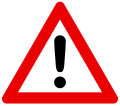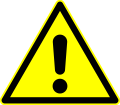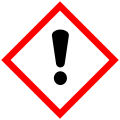Exclamation mark
|
!
|
|
|---|---|
| Punctuation marks | |
| Comma, comma | , |
| Semicolon, semicolon | ; |
| Colon, colon | : |
| Point | . |
| Ellipsis | ... |
| Focus | · |
| bullet point | • |
| Question mark | ? |
| Exclamation, exclamation, call signs | ! |
| Apostrophe, apostrophe | ' |
|
- - Hyphen ; Hyphen ; Supplementary line |
|
| Indent ; Up line | - |
|
quotation marks "" »« / «» ‚'› ‹ / ‹ › |
|
| Slashes / \ | |
| Brackets () [] | |
The exclamation mark (Germany and Switzerland; variants: exclamation especially Switzerland. Exclamation mark isolated in Germany and Switzerland) or the call sign (Austria and South Tyrol; variant: Call e sign . Esp Total Tyrol and Vorarlberg), a loan translation from Latin signum exclamationis , more rarely, Exclamation mark , ( ! ), Is a punctuation mark that follows exclamation , wish and request sentences as well as exclamation words and conditional indirect questions ( unrealis ). In Austria, the use of salutation in letters is widespread, while this practice is no longer common in Germany. In addition, this punctuation symbol symbolizes important and similar facts and represents some completely different meanings.
Emergence
Hartmut Günther , professor of German language and didactics at the University of Cologne , found the first exclamation mark in an edition from 1797 in a diachronic comparison of editions of Luther's translation of the Bible . It already fulfilled grammatical tasks and did not serve as previously assumed , only as intonation information.
The exclamation mark appeared in the 17th century under the name "callsign". The earliest evidence in Germany is probably the first print of Johann Fischart's "Ehezuchtbüchlein" Flöhhatz from 1573.
use
As a punctuation mark
German
As a punctuation mark, the exclamation mark appears in independent sentences, word groups or after individual words (also in headings and the like), namely after exclamations, calls, commands, requests, warnings, prohibitions, wishes, greetings and emphatic assertions.
Examples:
- "You must not!"
- "Do Not Enter!"
- "Stop!"
When speaking, the pitch drops towards the end of the sentence.
The exclamation mark is written to the last word of the sentence without spaces . In typographical usage, a narrow space is often inserted in front of the exclamation mark for better visual separation.
An exclamation mark in brackets "(!)" Informs you that the statement immediately in front of the brackets seems remarkable to the author of the sentence.
Example:
- Wikipedia contains 2,473,057 (!) Articles
In contrast to most of the Romance and Anglo-Saxon countries, the exclamation mark is used in German not only after direct invocation, but also for confirmation. However, this development is colloquial and originated in the early years of the Internet. In addition to the use of so-called emoticons , the multiple use of exclamation marks and question marks ("Tell me how ????") was used as additional emphasis in Internet forums and newsgroups , without any historical background. Due to the multiple use, the exclamation mark in the meaning of the pure volume emphasis has increasingly given way to a rating in the form of 'important': "Now only 5 percent !!!". The number of exclamation marks should therefore reflect the importance of what is said.
Out of this context, the ironic exaggeration !! 11einseinseinself arose as a substitute for many exclamation marks, the origin of which can be traced back to typing errors on the German keyboard (the number 1 and the exclamation mark are on the same key) (see Leetspeak ).
Armenian
In the Armenian script there is the բացականչական նշան ( batsaganchakan nshan , Unicode: U + 055C armenian exclamation mark ). Similar to a diacritical mark, it is placed on the stressed vowel of the statement; when typing on the computer it is entered after this vowel.
French
In French , a space is inserted before the exclamation mark after the last word of the sentence.
Example:
- Attention! La voiture quitte le garage. "(Warning! The car is leaving the garage.)"
If multiple exclamation marks are required, a space is also inserted after the last word of the sentence:
- Ouah !!! C'est une jolie photo. "(Oh yes !!! That is a nice photo.)"
Spanish: ""
In Spanish , the exclamation mark, which is called signo de exclamación , but sometimes also signo de admiración ("admiration mark "), exists in two forms. In addition to the "!" Character that concludes a sentence, which is also common in other languages, there is the opening exclamation mark "¡", which is placed in front of stressed sentences or words:
- ¡Atención!
If you want exclamation marks more than once, the opening exclamation mark is written as often as the closing one:
- ¡¡¡Atención !!!
In the case of a polite request - analogous to the language - it is emphasized, but not called out loud, i.e. only the stress sign is set:
- ¡Por favor llame. ("Please ring the bell")
As a phonetic sign
- in the International Phonetic Alphabet (IPA) for the postalveolar click sound
- in written languages of some Khoisan languages for the postalveolar click sound
Descriptor symbols
- Faculty (Mathematics) and Sub- Faculty , Mathematical Functions
- Not , the negation in many programming languages , also in combination with other operators (e.g. "! =" Corresponds to 'not equal', 'not equal')
- “#!” Is the shebang in Unix-like operating systems
- in chess notation
- (!) sufficiently good move
- ! good move
- !! brilliant move
- ! ? interesting move
- ?! questionable move
- ?? gross mistake, blunder
Symbolic meanings
The exclamation mark stands for “important” in general, especially for a warning (“attention”), or for “ danger ” and “ hazard ”.
Other uses
For student associations, the exclamation mark can be part of the liaison circle.
Character encoding and keyboard entry
The exclamation point in the ASCII character set is 21 hexadecimal ( Unicode U + 0021); it is the first visible character after the control characters and is therefore sorted in the first place depending on the sorting algorithm.
The reverse exclamation mark for the Spanish language is in ISO 8859-1 and Unicode on Code 161 (U + 00A1) and can be generated under Windows on any keyboard using Alt+ 0161or Alt+ 173on the number pad. On a Macintosh this is generated by Alt+ 1/!, on Linux / X11 by Shift+ AltGr+ 1/!.
The double exclamation mark ("‼") is encoded in Unicode as U + 203C.
In HTML, the exclamation mark can also be generated using the following codes:
| Coding | |
|---|---|
| decimal |
!
|
| hexadecimal |
!
|
| named entity |
!
|
See also
Web links
Single receipts
- ^ Wolfgang Mathias: Press Information 127/2002 - The Development of German Punctuation. University of Cologne, August 19, 2002, archived from the original on June 6, 2011 ; Retrieved February 28, 2013 .
- ↑ Flöh-Hatz / Weiber-Tratz. the wonderfully incorrect and ridiculously important right-handed deal between the Flöh and the weybern , Strasbourg 1601 edition ( digitized version ).
- ↑ Duden Comma, period and all other punctuation marks. With extensive collection of examples , Dudenverlag, 1998, p. 9.
- ^ W3C ( World Wide Web Consortium ): Character entity reference chart



